Customizing ComboBox in Xamarin ComboBox (SfComboBox)
22 Aug 202224 minutes to read
The Xamarin ComboBox (SfComboBox) control provides user friendly customizing options for both entry part and drop-down part. In this section, customizing the entire ComboBox control is explained.
Customizing the entry
The TextColor, TextSize, FontAttributes, FontFamily and BorderColor properties are used to customize the foreground color, font size, font attribute, font family and border color of the entry part.
Text color
The combo box control provides the user to customize the foreground color of the text inside the entry part.
Text size
The Xamarin ComboBox (SfComboBox) control provides the user to customize the text size of the text inside the entry part using TextSize property.
Font attributes
The combo box control provides the user to customize the font attribute of the text inside the entry part using FontAttributes property.
Font family
The combo box control provides the user to customize the font family of the text inside the entry part using FontFamily property.
Border color
The combo box control provides the user to customize the border color of the entry box using BorderColor property.
<StackLayout VerticalOptions="Start" HorizontalOptions="Start" Padding="30">
<combobox:SfComboBox HeightRequest="45" x:Name="comboBox" Text="Sample text" FontAttributes="Bold" TextColor="#1976d2" TextSize="20" BorderColor="#1976d2"/>
</StackLayout>StackLayout stackLayout = new StackLayout()
{
VerticalOptions = LayoutOptions.Start,
HorizontalOptions = LayoutOptions.Start,
Padding = new Thickness(30)
};
SfComboBox comboBox = new SfComboBox()
{
HeightRequest = 45,
Text = "Sample text",
TextColor = Color.FromHex("1976d2"),
TextSize = 20,
BorderColor = Color.FromHex("1976d2")
FontAttributes = FontAttributes.Bold
};
stackLayout.Children.Add(comboBox);
this.Content = stackLayout;
Changing delete button color
The ClearButtonColor property is used to modify the delete button color. The following code example shows changing delete button color.
<StackLayout VerticalOptions="Start" HorizontalOptions="Start" Padding="30">
<combobox:SfComboBox HeightRequest="40" x:Name="comboBox" IsEditableMode="True" ClearButtonColor="Red">
<combobox:SfComboBox.ComboBoxSource>
<ListCollection:List x:TypeArguments="x:String">
<x:String>Uganda</x:String>
<x:String>Ukraine</x:String>
<x:String>United Arab Emirates</x:String>
<x:String>United Kingdom</x:String>
</ListCollection:List>
</combobox:SfComboBox.ComboBoxSource>
</combobox:SfComboBox>
</StackLayout>StackLayout layout = new StackLayout()
{
VerticalOptions = LayoutOptions.Start,
HorizontalOptions = LayoutOptions.Start,
Padding = new Thickness(30)
};
List<String> countryNames = new List<String>();
countryNames.Add("Uganda");
countryNames.Add("Ukraine");
countryNames.Add("United Arab Emirates");
countryNames.Add("United Kingdom");
countryNames.Add("United States");
SfComboBox comboBox = new SfComboBox();
comboBox.DataSource = countryNames;
comboBox.ClearButtonColor = Color.Yellow;
comboBox.IsEditableMode = true;
layout.Children.Add(comboBox);
Content = layout;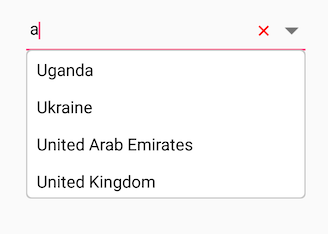
Changing delete button visibility
The ShowClearButton property is used to modify the visibility of delete button. The following code example shows changing delete button visibility.
<StackLayout VerticalOptions="Start" HorizontalOptions="Start" Padding="30">
<combobox:SfComboBox HeightRequest="40" x:Name="comboBox" IsEditableMode="True" IsEditableMode="True" ShowClearButton="False">
<combobox:SfComboBox.ComboBoxSource>
<ListCollection:List x:TypeArguments="x:String">
<x:String>Uganda</x:String>
<x:String>Ukraine</x:String>
<x:String>United Arab Emirates</x:String>
<x:String>United Kingdom</x:String>
</ListCollection:List>
</combobox:SfComboBox.ComboBoxSource>
</combobox:SfComboBox>
</StackLayout>StackLayout layout = new StackLayout()
{
VerticalOptions = LayoutOptions.Start,
HorizontalOptions = LayoutOptions.Start,
Padding = new Thickness(30)
};
List<String> countryNames = new List<String>();
countryNames.Add("Uganda");
countryNames.Add("Ukraine");
countryNames.Add("United Arab Emirates");
countryNames.Add("United Kingdom");
countryNames.Add("United States");
SfComboBox comboBox = new SfComboBox();
comboBox.DataSource = countryNames;
comboBox.ShowClearButton = false;
comboBox.IsEditableMode = true;
layout.Children.Add(comboBox);
Content = layout;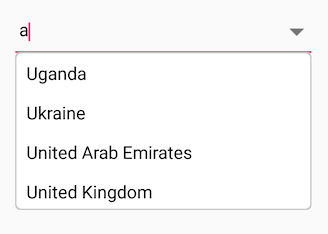
Changing border visibility
The ShowBorder property is used to modify the visibility of border. The following code example shows changing border visibility.
<StackLayout VerticalOptions="Start" HorizontalOptions="Start" Padding="30">
<combobox:SfComboBox HeightRequest="40" x:Name="comboBox" IsEditableMode="True" IsEditableMode="True" ShowBorder="False">
<combobox:SfComboBox.ComboBoxSource>
<ListCollection:List x:TypeArguments="x:String">
<x:String>Uganda</x:String>
<x:String>Ukraine</x:String>
<x:String>United Arab Emirates</x:String>
<x:String>United Kingdom</x:String>
</ListCollection:List>
</combobox:SfComboBox.ComboBoxSource>
</combobox:SfComboBox>
</StackLayout>StackLayout layout = new StackLayout()
{
VerticalOptions = LayoutOptions.Start,
HorizontalOptions = LayoutOptions.Start,
Padding = new Thickness(30)
};
List<String> countryNames = new List<String>();
countryNames.Add("Uganda");
countryNames.Add("Ukraine");
countryNames.Add("United Arab Emirates");
countryNames.Add("United Kingdom");
countryNames.Add("United States");
SfComboBox comboBox = new SfComboBox();
comboBox.DataSource = countryNames;
comboBox.ShowBorder = false;
comboBox.IsEditableMode = true;
layout.Children.Add(comboBox);
Content = layout;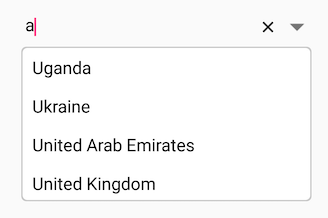
CustomView for ComboBox
CustomView property has used to provide the custom view instead of entry in ComboBox. It’s default height and width has control height and width.
<StackLayout VerticalOptions="Start" HorizontalOptions="Start" Padding="30">
<combobox:SfComboBox HeightRequest="40" x:Name="comboBox">
<combobox:SfComboBox.CustomView>
<Label x:Name="customLabel" HeightRequest="40" Text="ComboBox" VerticalTextAlignment="Center"/>
</combobox:SfComboBox.CustomView>
</combobox:SfComboBox>
</StackLayout>StackLayout layout = new StackLayout()
{
VerticalOptions = LayoutOptions.Start,
HorizontalOptions = LayoutOptions.Start,
Padding = new Thickness(30)
};
Label customLabel = new Label();
customLabel.HeightRequest = 40;
customLabel.VerticalTextAlignment = TextAlignment.Center;
customLabel.Text = "ComboBox";
SfComboBox comboBox = new SfComboBox();
comboBox.HeightRequest = 40;
comboBox.DataSource = countryNames;
comboBox.SuggestionBoxPlacement = SuggestionBoxPlacement.Top;
comboBox.CustomView = customLabel;
layout.Children.Add(comboBox);
Content = layout;
NOTE
SfComboBoxClearButton will not be supported when using Custom View.
Custom template for suggestion items
The ItemTemplate property helps to decorate suggestion items with custom templates. The following code explains the steps to add an image to the suggestion list item.
public class Person
{
private int age;
public int Age
{
get { return age; }
set { age = value; }
}
private string name;
public string Name
{
get { return name; }
set { name = value; }
}
}
public class PersonViewModel
{
private ObservableCollection<Person> personCollection;
public ObservableCollection<Person> PersonCollection
{
get { return personCollection; }
set { personCollection = value; }
}
public PersonViewModel()
{
personCollection = new ObservableCollection<Person>();
personCollection.Add(new Person() { Age = 21, Name = "Aldan" });
personCollection.Add(new Person() { Age = 25, Name = "Clara" });
personCollection.Add(new Person() { Age = 23, Name = "Aldrin" });
personCollection.Add(new Person() { Age = 25, Name = "Mark" });
personCollection.Add(new Person() { Age = 25, Name = "Lucas" });
personCollection.Add(new Person() { Age = 24, Name = "Alan" });
personCollection.Add(new Person() { Age = 25, Name = "James" });
personCollection.Add(new Person() { Age = 22, Name = "Aaron" });
}
}Now populate this PersonViewModel data in SfComboBox control by binding with DataSource property.
<ContentPage xmlns="http://xamarin.com/schemas/2014/forms"
xmlns:x="http://schemas.microsoft.com/winfx/2009/xaml"
xmlns:combobox="clr-namespace:Syncfusion.XForms.ComboBox;assembly=Syncfusion.SfComboBox.XForms"
xmlns:local="clr-namespace:NamespaceName"
x:Class="NamespaceName.ClassName">
<ContentPage.BindingContext>
<local:PersonViewModel/>
</ContentPage.BindingContext>
<StackLayout VerticalOptions="Start" HorizontalOptions="Start" Padding="30">
<combobox:SfComboBox HeightRequest="40" x:Name="comboBox" DisplayMemberPath="Name" DataSource="{Binding PersonCollection}">
<combobox:SfComboBox.ItemTemplate>
<DataTemplate>
<StackLayout Orientation="Horizontal">
<Image Source="User.png" WidthRequest="12"/>
<Label Text="{Binding Name}" />
</StackLayout>
</DataTemplate>
</combobox:SfComboBox.ItemTemplate>
</combobox:SfComboBox>
</StackLayout>
</ContentPage>DataTemplate itemTemplate = new DataTemplate(() =>
{
StackLayout stack;
Image image;
Label label;
stack = new StackLayout();
stack.Orientation = StackOrientation.Horizontal;
image = new Image();
image.Source = (FileImageSource)ImageSource.FromFile("User.png");
label = new Label();
label.SetBinding(Label.TextProperty, "Name");
stack.Children.Add(image);
stack.Children.Add(label);
return new ViewCell { View = stack };
});
StackLayout layout = new StackLayout()
{
VerticalOptions = LayoutOptions.Start,
HorizontalOptions = LayoutOptions.Start,
Padding = new Thickness(30)
};
SfComboBox comboBox = new ComboBox();
comboBox.HeightRequest = 40;
comboBox.BindingContext = new PersonViewModel();
Binding binding = new Binding("PersonCollection");
binding.Source = this;
binding.Mode = BindingMode.TwoWay;
comboBox.SetBinding(Label.DataSourceProperty,binding);
comboBox.ItemTemplate = itemTemplate;
layout.Children.Add(comboBox);
Content = layout;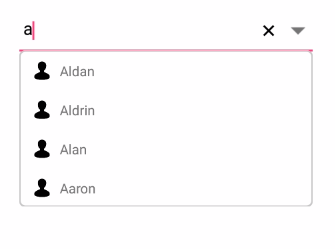
Customizing the suggestion box
Changing suggestion item height
The DropDownItemHeight property is used to modify the height of suggestion items in drop-down list. The following code example shows changing suggestion item height.
<StackLayout VerticalOptions="Start" HorizontalOptions="Start" Padding="30">
<combobox:SfComboBox HeightRequest="40" x:Name="comboBox" DropDownItemHeight="50">
<combobox:SfComboBox.ComboBoxSource>
<ListCollection:List x:TypeArguments="x:String">
<x:String> Uganda </x:String>
<x:String> Ukraine </x:String>
<x:String> United Arab Emirates </x:String>
<x:String> United Kingdom </x:String>
</ListCollection:List>
</combobox:SfComboBox.ComboBoxSource>
</combobox:SfComboBox>
</StackLayout>StackLayout layout = new StackLayout()
{
VerticalOptions = LayoutOptions.Start,
HorizontalOptions = LayoutOptions.Start,
Padding = new Thickness(30)
};
List<String> countryNames = new List<String>();
countryNames.Add("Uganda");
countryNames.Add("Ukraine");
countryNames.Add("United Arab Emirates");
countryNames.Add("United Kingdom");
SfComboBox comboBox = new SfComboBox();
comboBox.DataSource = countryNames;
comboBox.DropDownItemHeight = 50;
layout.Children.Add(comboBox);
Content = layout;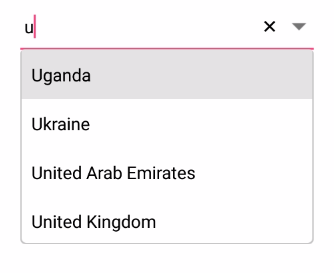
Changing suggestion box width
The DropDownWidth property is used to modify the width of suggestion box. The following code example shows changing suggestion box width.
<StackLayout VerticalOptions="Start" HorizontalOptions="Start" Padding="30">
<combobox:SfComboBox HeightRequest="40" x:Name="comboBox" DropDownWidth="300">
<combobox:SfComboBox.ComboBoxSource>
<ListCollection:List x:TypeArguments="x:String">
<x:String>Uganda</x:String>
<x:String>Ukraine</x:String>
<x:String>United Arab Emirates</x:String>
<x:String>United Kingdom</x:String>
</ListCollection:List>
</combobox:SfComboBox.ComboBoxSource>
</combobox:SfComboBox>
</StackLayout>StackLayout layout = new StackLayout()
{
VerticalOptions = LayoutOptions.Start,
HorizontalOptions = LayoutOptions.Start,
Padding = new Thickness(30)
};
List<String> countryNames = new List<String>();
countryNames.Add("Uganda");
countryNames.Add("Ukraine");
countryNames.Add("United Arab Emirates");
countryNames.Add("United Kingdom");
countryNames.Add("United States");
SfComboBox comboBox = new SfComboBox();
comboBox.DataSource = countryNames;
comboBox.DropDownWidth = 300;
layout.Children.Add(comboBox);
Content = layout;
Changing suggestion box corner radius
The DropDownCornerRadius property is used to modify the corner radius of suggestion box. The following code example shows changing suggestion box corner radius.
<StackLayout VerticalOptions="Start" HorizontalOptions="Start" Padding="30">
<combobox:SfComboBox HeightRequest="40" x:Name="comboBox" DropDownCornerRadius="3">
<combobox:SfComboBox.ComboBoxSource>
<ListCollection:List x:TypeArguments="x:String">
<x:String>Uganda</x:String>
<x:String>Ukraine</x:String>
<x:String>United Arab Emirates</x:String>
<x:String>United Kingdom</x:String>
</ListCollection:List>
</combobox:SfComboBox.ComboBoxSource>
</combobox:SfComboBox>
</StackLayout>StackLayout layout = new StackLayout()
{
VerticalOptions = LayoutOptions.Start,
HorizontalOptions = LayoutOptions.Start,
Padding = new Thickness(30)
};
List<String> countryNames = new List<String>();
countryNames.Add("Uganda");
countryNames.Add("Ukraine");
countryNames.Add("United Arab Emirates");
countryNames.Add("United Kingdom");
countryNames.Add("United States");
SfComboBox comboBox = new SfComboBox();
comboBox.DataSource = countryNames;
comboBox.DropDownCornerRadius = 3;
layout.Children.Add(comboBox);
Content = layout;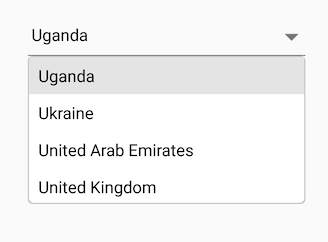
Changing suggestion box background color
The DropDownBackgroundColor property is used to modify the background color of suggestion box. The following code example shows changing suggestion box background color.
<StackLayout VerticalOptions="Start" HorizontalOptions="Start" Padding="30">
<combobox:SfComboBox HeightRequest="40" x:Name="comboBox" DropDownBackgroundColor="Yellow">
<combobox:SfComboBox.ComboBoxSource>
<ListCollection:List x:TypeArguments="x:String">
<x:String>Uganda</x:String>
<x:String>Ukraine</x:String>
<x:String>United Arab Emirates</x:String>
<x:String>United Kingdom</x:String>
</ListCollection:List>
</combobox:SfComboBox.ComboBoxSource>
</combobox:SfComboBox>
</StackLayout>StackLayout layout = new StackLayout()
{
VerticalOptions = LayoutOptions.Start,
HorizontalOptions = LayoutOptions.Start,
Padding = new Thickness(30)
};
List<String> countryNames = new List<String>();
countryNames.Add("Uganda");
countryNames.Add("Ukraine");
countryNames.Add("United Arab Emirates");
countryNames.Add("United Kingdom");
countryNames.Add("United States");
SfComboBox comboBox = new SfComboBox();
comboBox.DataSource = countryNames;
comboBox.DropDownBackgroundColor = Color.Yellow;
layout.Children.Add(comboBox);
Content = layout;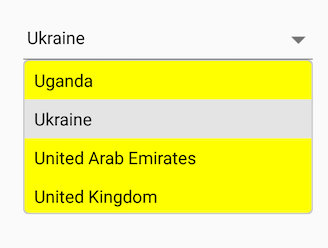
Changing the border color of suggestion box
The DropDownBorderColor property is used to change the border color of suggestion box. The following code example demonstrates how to change the border color of suggestion box.
<StackLayout>
<comboBox:SfComboBox HeightRequest="40" DropDownBorderColor="Blue">
<comboBox:SfComboBox.ComboBoxSource>
<ListCollection:List x:TypeArguments="x:String">
<x:String>1920 x 1080</x:String>
<x:String>1680 x 1050</x:String>
<x:String>1600 x 900</x:String>
<x:String>1440 x 900</x:String>
<x:String>1400 x 1050</x:String>
<x:String>1366 x 768</x:String>
<x:String>1360 x 768</x:String>
<x:String>1280 x 1024</x:String>
<x:String>1280 x 960</x:String>
<x:String>1280 x 720</x:String>
<x:String>854 x 480</x:String>
<x:String>800 x 480</x:String>
<x:String>480 X 640</x:String>
<x:String>480 x 320</x:String>
<x:String>432 x 240</x:String>
<x:String>360 X 640</x:String>
<x:String>320 x 240</x:String>
</ListCollection:List>
</comboBox:SfComboBox.ComboBoxSource>
</comboBox:SfComboBox>
</StackLayout>StackLayout layout = new StackLayout()
{
VerticalOptions = LayoutOptions.Start,
HorizontalOptions = LayoutOptions.Start,
Padding = new Thickness(30)
};
List<String> resolutionList = new List<String>();
resolutionList.Add("1920 x 1080");
resolutionList.Add("1680 x 1050");
resolutionList.Add("1600 x 900");
resolutionList.Add("1440 x 900");
resolutionList.Add("1400 x 1050");
resolutionList.Add("1366 x 768");
resolutionList.Add("1360 x 768");
resolutionList.Add("1280 x 1024");
resolutionList.Add("1280 x 960");
resolutionList.Add("1280 x 720");
resolutionList.Add("854 x 480");
resolutionList.Add("800 x 480");
resolutionList.Add("480 X 640");
resolutionList.Add("480 x 320");
resolutionList.Add("432 x 240");
resolutionList.Add("360 X 640");
resolutionList.Add("320 x 240");
SfComboBox comboBox = new SfComboBox();
comboBox.HeightRequest = 40;
comboBox.ComboBoxSource = resolutionList;
comboBox.DropDownBorderColor = Color.Blue;
layout.Children.Add(comboBox);
Content = layout;
Customizing suggestion items
Suggestion box items can be customized using the DropDownItemFontAttributes, DropDownItemFontFamily, DropDownTextSize and DropDownTextColor properties.
<StackLayout VerticalOptions="Start" HorizontalOptions="Start" Padding="30">
<combobox:SfComboBox HeightRequest="40" x:Name="comboBox" DropDownTextSize="16" DropDownTextColor="#1976d2">
<combobox:SfComboBox.ComboBoxSource>
<ListCollection:List x:TypeArguments="x:String">
<x:String> Uganda </x:String>
<x:String> Ukraine </x:String>
<x:String> United Arab Emirates </x:String>
<x:String> United Kingdom </x:String>
<x:String> United States </x:String>
</ListCollection:List>
</combobox:SfComboBox.ComboBoxSource>
</combobox:SfComboBox>
</StackLayout>StackLayout layout = new StackLayout()
{
VerticalOptions = LayoutOptions.Start,
HorizontalOptions = LayoutOptions.Start,
Padding = new Thickness(30)
};
List<String> countryNames = new List<String>();
countryNames.Add("Uganda");
countryNames.Add("Ukraine");
countryNames.Add("United Arab Emirates");
countryNames.Add("United Kingdom");
countryNames.Add("United States");
SfComboBox comboBox = new SfComboBox();
comboBox.DataSource = countryNames;
comboBox.DropDownTextColor = Color.FromHex("#1976d2");
comboBox.DropDownTextSize = 16;
layout.Children.Add(comboBox);
Content = layout;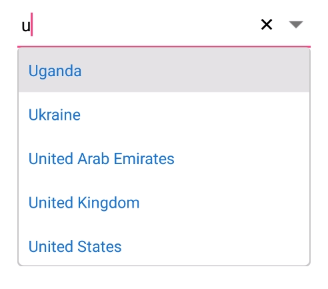
Changing selected item color in suggestion box
The SelectedDropDownItemColor property is used to modify text color of selected item in drop down. The following code example shows changing the selected item text color in drop down.
<StackLayout VerticalOptions="Start" HorizontalOptions="Start" Padding="30">
<combobox:SfComboBox HeightRequest="40" x:Name="comboBox" SelectedDropDownItemColor="Blue">
<combobox:SfComboBox.ComboBoxSource>
<ListCollection:List x:TypeArguments="x:String">
<x:String>Uganda</x:String>
<x:String>Ukraine</x:String>
<x:String>United Arab Emirates</x:String>
<x:String>United Kingdom</x:String>
</ListCollection:List>
</combobox:SfComboBox.ComboBoxSource>
</combobox:SfComboBox>
</StackLayout>StackLayout layout = new StackLayout()
{
VerticalOptions = LayoutOptions.Start,
HorizontalOptions = LayoutOptions.Start,
Padding = new Thickness(30)
};
List<String> countryNames = new List<String>();
countryNames.Add("Uganda");
countryNames.Add("Ukraine");
countryNames.Add("United Arab Emirates");
countryNames.Add("United Kingdom");
countryNames.Add("United States");
SfComboBox comboBox = new SfComboBox();
comboBox.DataSource = countryNames;
comboBox.SelectedDropDownItemColor = Color.Blue;
layout.Children.Add(comboBox);
Content = layout;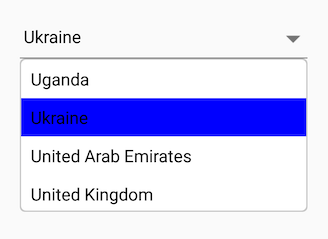
DropDown button customization
This section explains various DropDown button settings available in SfComboBox control.
<StackLayout VerticalOptions="Start" HorizontalOptions="Start" Padding="30">
<combobox:SfComboBox HeightRequest="40" x:Name="comboBox">
<combobox:SfComboBox.ComboBoxSource>
<ListCollection:List x:TypeArguments="x:String">
<x:String> Uganda </x:String>
<x:String> Ukraine </x:String>
<x:String> United Arab Emirates </x:String>
<x:String> United Kingdom </x:String>
<x:String> United States </x:String>
</ListCollection:List>
</combobox:SfComboBox.ComboBoxSource>
<combobox:SfComboBox.DropDownButtonSettings>
<combobox:DropDownButtonSettings Width="40" Height="40" HighlightedBackgroundColor="Green" BackgroundColor="Red" HighlightFontColor="Red"/>
</combobox:SfComboBox.DropDownButtonSettings>
</combobox:SfComboBox>
</StackLayout>StackLayout layout = new StackLayout()
{
VerticalOptions = LayoutOptions.Start,
HorizontalOptions = LayoutOptions.Start,
Padding = new Thickness(30)
};
List<String> countryNames = new List<String>();
countryNames.Add("Uganda");
countryNames.Add("Ukraine");
countryNames.Add("United Arab Emirates");
countryNames.Add("United Kingdom");
countryNames.Add("United States");
SfComboBox comboBox = new SfComboBox();
comboBox.DataSource = countryNames;
DropDownButtonSettings dropDownButtonSettings = new DropDownButtonSettings();
dropDownButtonSettings.Height = 40;
dropDownButtonSettings.Width = 40;
dropDownButtonSettings.HighlightedBackgroundColor = Color.Green;
dropDownButtonSettings.BackgroundColor = Color.Red;
dropDownButtonSettings.HighlightFontColor = Color.Red;
comboBox.DropDownButtonSettings = dropDownButtonSettings;
layout.Children.Add(comboBox);
Content = layout;
View for drop down button
This section explains how to provide view to the drop down button.
<StackLayout VerticalOptions="Start" HorizontalOptions="Start" Padding="30">
<comboBox:SfComboBox HeightRequest="40" x:Name="comboBox">
<comboBox:SfComboBox.ComboBoxSource>
<ListCollection:List x:TypeArguments="x:String">
<x:String>Uganda</x:String>
<x:String>Ukraine</x:String>
<x:String>United Arab Emirates</x:String>
<x:String>United Kingdom</x:String>
<x:String>United States</x:String>
</ListCollection:List>
</comboBox:SfComboBox.ComboBoxSource>
<comboBox:SfComboBox.DropDownButtonSettings>
<comboBox:DropDownButtonSettings Width="40" Height="40">
<comboBox:DropDownButtonSettings.View>
<Label WidthRequest="30" Text="Click" HorizontalTextAlignment="Center" VerticalTextAlignment="Center"/>
</comboBox:DropDownButtonSettings.View>
</comboBox:DropDownButtonSettings>
</comboBox:SfComboBox.DropDownButtonSettings>
</comboBox:SfComboBox>
</StackLayout>StackLayout layout = new StackLayout()
{
VerticalOptions = LayoutOptions.Start,
HorizontalOptions = LayoutOptions.Start,
Padding = new Thickness(30)
};
List<String> countryNames = new List<String>();
countryNames.Add("Uganda");
countryNames.Add("Ukraine");
countryNames.Add("United Arab Emirates");
countryNames.Add("United Kingdom");
countryNames.Add("United States");
SfComboBox comboBox = new SfComboBox();
comboBox.DataSource = countryNames;
DropDownButtonSettings dropDownButtonSettings = new DropDownButtonSettings();
dropDownButtonSettings.Height = 40;
dropDownButtonSettings.Width = 40;
Label label = new Label();
label.Text = "Click";
label.VerticalTextAlignment = TextAlignment.Center;
label.HorizontalTextAlignment = TextAlignment.Center;
label.WidthRequest = 30;
dropDownButtonSettings.View = label;
comboBox.DropDownButtonSettings = dropDownButtonSettings;
layout.Children.Add(comboBox);
Content = layout;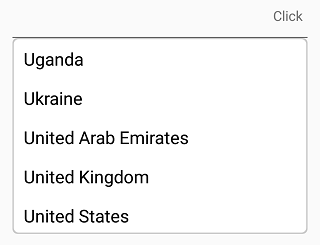
Watermark
Watermark provides a short note about the type of input to enter in the editor control. Watermarks are visible only if the text is empty. It will reappear if the text is cleared. The following example, explains the usability of watermark that hints users to start with the character “U”.
<StackLayout VerticalOptions="Start" HorizontalOptions="Start" Padding="30">
<combobox:SfComboBox HeightRequest="40" Watermark="Enter 'U' to filter suggestions" x:Name="comboBox" />
</StackLayout>StackLayout layout = new StackLayout()
{
VerticalOptions = LayoutOptions.Start,
HorizontalOptions = LayoutOptions.Start,
Padding = new Thickness(30)
};
SfComboBox comboBox = new SfComboBox();
comboBox.Watermark = "Enter 'U' to filter suggestions";
layout.Children.Add(comboBox);
Content = layout;
Changing Watermark Text Color
Text color of watermark can be customized using WatermarkColor property.
<StackLayout VerticalOptions="Start" HorizontalOptions="Start" Padding="30">
<combobox:SfComboBox HeightRequest="40" Watermark="Enter some text" WatermarkColor="#1976d2" x:Name="comboBox" />
</StackLayout>StackLayout layout = new StackLayout()
{
VerticalOptions = LayoutOptions.Start,
HorizontalOptions = LayoutOptions.Start,
Padding = new Thickness(30)
};
SfComboBox comboBox = new SfComboBox();
comboBox.Watermark = "Enter some text";
comboBox.WatermarkColor = Color.FromHex("1976d2");
layout.Children.Add(comboBox);
Content = layout;
Select text on focus
The SelectAllOnFocus property specifies whether the text should be selected when the input field is focused.
<?xml version="1.0" encoding="utf-8" ?>
<ContentPage xmlns="http://xamarin.com/schemas/2014/forms"
xmlns:x="http://schemas.microsoft.com/winfx/2009/xaml"
xmlns:ListCollection="clr-namespace:System.Collections.Generic;assembly=netstandard"
xmlns:combobox="clr-namespace:Syncfusion.XForms.ComboBox;assembly=Syncfusion.SfComboBox.XForms"
xmlns:local="clr-namespace:NamespaceName"
x:Class="NamespaceName.ClassName">
<StackLayout VerticalOptions="Start" HorizontalOptions="Start" Padding="30">
<combobox:SfComboBox HeightRequest="40" SelectAllOnFocus="true" IsEditableMode="true" x:Name="comboBox">
<combobox:SfComboBox.ComboBoxSource>
<ListCollection:List x:TypeArguments="x:String">
<x:String>Frank</x:String>
<x:String>James</x:String>
<x:String>Steve</x:String>
<x:String>Lucas</x:String>
<x:String>Mark</x:String>
</ListCollection:List>
</combobox:SfComboBox.ComboBoxSource>
</combobox:SfComboBox>
</StackLayout>
</ContentPage>namespace ComboBoxSample
{
public partial class MainPage : ContentPage
{
public MainPage()
{
InitializeComponent();
StackLayout layout = new StackLayout()
{
VerticalOptions = LayoutOptions.Start,
HorizontalOptions = LayoutOptions.Start,
Padding = new Thickness(30)
};
List<String> resolutionList = new List<String>();
resolutionList.Add("Frank");
resolutionList.Add("James");
resolutionList.Add("Steve");
resolutionList.Add("Lucas");
resolutionList.Add("Mark");
SfComboBox comboBox = new SfComboBox();
comboBox.HeightRequest = 40;
comboBox.SelectAllOnFocus = "true"
comboBox.IsEditableMode = "true"
comboBox.ComboBoxSource = resolutionList;
layout.Children.Add(comboBox);
Content = layout;
}
}
}